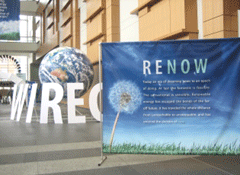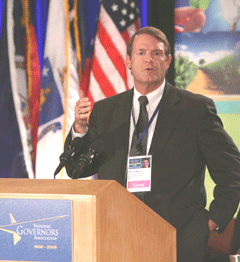Clean Energy Future?
Air Date: Week of March 7, 2008

Renewable energy enthusiasts see big growth on the horizon but some doubt if wind, solar and geothermal can power replace old-fashioned coal. (Photo: Washington International Renewable Energy Conference)
What do leaders in business see in our energy future? Living on Earth’s Jeff Young learns it depends which big business you ask.
Transcript
CURWOOD: Renewable energy sources – wind, solar and geothermal – are growing rapidly in the U.S. But the clean energy industry warns that growth could stall, unless Congress extends tax credits set to expire at the end of the year. Venture capital investor Nancy Floyd:
FLOYD: The renewables industry globally will continue to grow, but the industry in this country will come to a virtual standstill.
CURWOOD: What Congress does today will set the country’s energy policy for decades to come. And that also means lawmakers will chart the course for our economy and the climate. They’re getting a lot of advice, especially from the CEO’s of some of the biggest companies. Living on Earth’s Jeff Young tells us those corporations don’t see eye to eye on America’s energy future.
YOUNG: Energy was at the top of the agenda when the nation’s governors met in Washington. They’re worried: they see soaring fuel costs, environmental concerns, and charts that show projected demand for power curving upward like a mountain with no peak in sight. They invited the leaders of major electric utilities to weigh in on what’s in store. Dominion CEO Tom Farrell was not encouraging.
FARRELL: I’m not an alarmist by nature. I do believe, however, that our nation is headed for an energy train wreck.
YOUNG: The wreck Farrell sees coming is when booming power demand bumps up against any aggressive global warming laws. Dominion has energy customers in 11 states. It’s planning both a new coal and nuclear plant in its home state, Virginia. Dominion’s also putting up some wind facilities. But Farrell has low expectations for alternative energy.
FARRELL: We all want a clean healthy environment. But I urge you to beware of those who say we can have it for free. They are singing a siren’s song.
YOUNG: Next, the governors heard Michael Morris of American Electric Power. AEP burns coal to generate three quarters of its electricity in the Midwest. Morris plans a new coal plant with advanced technology that could allow it to capture CO2 and store it underground. He warned against any action that would cut the use of coal.

American Electric Power’s Michael Morris warns governors that the idea of reducing the use of coal is “something we should all be frightened by.” (Photo: Washington International Renewable Energy Conference)
MORRIS: And the whole notion of de-legitimizing coal is something that we should all be frightened by. Coal is our biggest resource and something that we need to lean on and lean on as hard as we can as we go forward.
YOUNG: The governors apparently got the message. They chose not to act on a modest global warming resolution by Minnesota Governor Tim Pawlenty. But the message was quite different at another energy gathering in Washington.
[APPLAUSE]
HAYWARD: Ladies and Gentlemen, good morning. It’s a great pleasure to be at third international renewable energy conference.
YOUNG: Tony Hayward’s company BP helped sponsor the year’s biggest gathering of government officials and renewable energy businesses. BP invested a billion dollars in renewables last year and plans one point five billion in ‘08, a lot of it in the U.S. BP owns the most wind power acreage and runs the country’s largest solar equipment facility.
HAYWARD: America is the world’s biggest energy consumer, and any serious change in global energy consumption patterns has to begin here.
YOUNG: Hayward wants Washington to pass a law to put a price on carbon emissions. That would make cleaner sources, now much more expensive than fossil fuels, more attractive. Electricity from wind is now about 50 percent pricier than that from coal; solar is from three to five times as costly as coal.
A lot of companies are working to bring down those costs, including some not even in the energy business, like Google. The information technology giant recently launched a campaign that goes by an engineering formula: RE less than C –that’s renewable energy less than coal.
REICHER: So we’ve set ourselves a pretty aggressive goal, which is to make renewable electricity, from solar to wind to geothermal, cheaper than coal.

Renewable energy enthusiasts see big growth on the horizon but some doubt if wind, solar and geothermal can power replace old-fashioned coal. (Photo: Washington International Renewable Energy Conference)
YOUNG: That’s Dan Reicher. He took over Google’s energy initiatives after eight years in President Clinton’s energy department. Google’s putting engineers, scientists and investment capital to work on potential breakthrough technologies in clean energy. And Reicher sees a role for Google’s better known pursuits on the net.
REICHER: What can we do with Google earth and Google maps and You Tube to really get the word out about renewable electricity.
YOUNG: I hear from folks in the electric utility industry that we’d be fools to turn our backs on coal. What do you think? Can you envision this country without coal in the near future?
Reicher: Coal is not going away anytime soon, but what renewable electricity combined with energy efficiency offers is the chance to slow down the growth of coal and to begin to wean ourselves off existing coal-fired power plants.
YOUNG: Google has big ambitions, but I wanted the really big business picture, and business doesn’t get much bigger than GE. GE Energy’s Vice President for renewables, Victor Abate, says the company’s invested billions in alternative energy and sees tremendous growth on the horizon. He expects wind, now just a little over one percent of the U.S. electricity mix, to be five or ten times that.
ABATE: Right around the corner – 2015, 2020. The size could be five, ten percent without too much of a stretch in our view.
YOUNG: Who’s right, here? The boosters on the renewables side or the fossil fuel folks?
ABATE: Our view is they’re both right. We’ve for the past hundred years built a power generation infrastructure of about a thousand gigawats. The question is for the next 100 years what’s the next thousand look like? And that mix we think is going to be dramatically different. You’ll still need coal, gas, and nuclear and we’re investing in those. But the percentage of renewables won’t be one percent.
YOUNG: Want more windmills? GE can make them. And who supplies equipment for the coal and nuclear plants AEP and Dominion want to build? That’s right – GE. It’s one of the little perks of being one of the world’s largest corporations: they profit no matter what energy course the country chooses. For Living on Earth, I’m Jeff Young in Washington.
Links
Check out LOE’s series on coal
More about Google’s energy initiative, RE
Living on Earth wants to hear from you!
Living on Earth
62 Calef Highway, Suite 212
Lee, NH 03861
Telephone: 617-287-4121
E-mail: comments@loe.org
Newsletter [Click here]
Donate to Living on Earth!
Living on Earth is an independent media program and relies entirely on contributions from listeners and institutions supporting public service. Please donate now to preserve an independent environmental voice.
NewsletterLiving on Earth offers a weekly delivery of the show's rundown to your mailbox. Sign up for our newsletter today!
 Sailors For The Sea: Be the change you want to sea.
Sailors For The Sea: Be the change you want to sea.
 The Grantham Foundation for the Protection of the Environment: Committed to protecting and improving the health of the global environment.
The Grantham Foundation for the Protection of the Environment: Committed to protecting and improving the health of the global environment.
 Contribute to Living on Earth and receive, as our gift to you, an archival print of one of Mark Seth Lender's extraordinary wildlife photographs. Follow the link to see Mark's current collection of photographs.
Contribute to Living on Earth and receive, as our gift to you, an archival print of one of Mark Seth Lender's extraordinary wildlife photographs. Follow the link to see Mark's current collection of photographs.
 Buy a signed copy of Mark Seth Lender's book Smeagull the Seagull & support Living on Earth
Buy a signed copy of Mark Seth Lender's book Smeagull the Seagull & support Living on Earth

